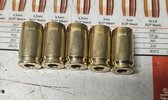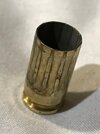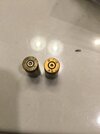gifbohane
Member
- Joined
- Nov 7, 2016
- Messages
- 1,180
OK. Many guys ask how many reloads can I get out of say 9MM cases? So now I am.
The stock answer is until the neck splits or I lose them in the grass.
I have an experiment going on that theory. I have a few thousand that are on their fifth cycle and have not had split necks or been lost....yet.
Now, in addition to five timers I have a bucket load of "once fired" that may or not be once fired since they are range pick up.
My plan was to find out how many firings it took to split the necks on this batch, none yet. BTW they are Blazer, FN, and Win. Also, I do not push the pressures.
Thinking about maybe one more loading and starting a new batch on their trip to 6 loadings. And sending this batch to recycler.
Thoughts from you all?
The stock answer is until the neck splits or I lose them in the grass.
I have an experiment going on that theory. I have a few thousand that are on their fifth cycle and have not had split necks or been lost....yet.
Now, in addition to five timers I have a bucket load of "once fired" that may or not be once fired since they are range pick up.
My plan was to find out how many firings it took to split the necks on this batch, none yet. BTW they are Blazer, FN, and Win. Also, I do not push the pressures.
Thinking about maybe one more loading and starting a new batch on their trip to 6 loadings. And sending this batch to recycler.
Thoughts from you all?






